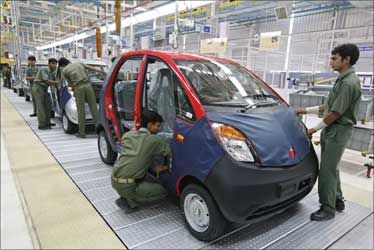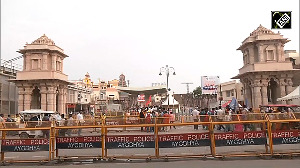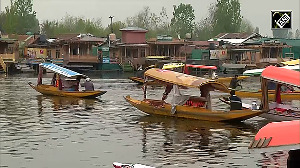 With an aim of boosting manufacturing and exports amid sharp fall in the rupee, the government has decided to take a slew of steps, including enhancing steel production capacity to 300 million tonnes and raising textile exports by 30 per cent this year.
With an aim of boosting manufacturing and exports amid sharp fall in the rupee, the government has decided to take a slew of steps, including enhancing steel production capacity to 300 million tonnes and raising textile exports by 30 per cent this year.
At a meeting of high level committee here, it was decided that push should be given to creation of domestic manufacturing capabilities, with Prime Minister Manmohan Singh saying sustained growth in manufacturing is critical if the country has to grow at 8-9 per cent.
He talked about the need to remove "bottlenecks that hinder" progress in manufacturing. Singh also gave a go-ahead to building of 70-100 seater civilian aircraft, a dream project which has been in the pipeline for years and a pilot project for electric and hybrid vehicles in Delhi by August.
The High Level Committee on Manufacturing decided that steps will be taken to build 300 million tonnes of steel capacity through Special Purpose Vehicles (SPVs) of Central Public Sector Enterprises with states by 2025.
The Steel Ministry would prepare a road map with time lines for the purpose in eight weeks. This will be a significant jump in the targeted capacity-building as steel production this year is expected to be 120 million tonnes. The capacity was 89 million tonnes in 2011-12.
The meeting also decided that quick decisions would be taken on raising textile exports by 30 per cent this year. In the last fiscal, textiles exports were about $34 billion. An Inter-Ministerial Group under Secretary (Textiles) will work out the Action Plan in four weeks.
These decisions are crucial as these come against the backdrop of the government's keenness to boost manufacturing and exports amidst falling value of the rupee. The rupee on Monday hit the all-time low when it crossed the 61 mark.
Addressing the meeting, Singh said manufacturing has to be the backbone of the growth strategy over the next decade. "We are witnessing a major shift in the structure of our economy. Agriculture, which continues to account for more than 50 per cent of our population, today constitutes less than 15 per cent of our GDP.
"If we have to grow at 8-9 per cent in the future, this has to come through sustained growth in manufacturing, particularly labour-intensive manufacturing. Manufacturing and manufacturing alone can absorb all those who need better livelihood opportunities," he said.
Noting that there are certain manufacturing sectors which have done well over the last 20 years, the Prime Minister said automobiles, auto-components, pharmaceuticals, metals and cement are some such areas which quickly come to one's mind.
"However, we have not been able to leverage our strengths both in traditional industries and in emerging sectors to the extent we could have," Singh said. Referring to electronics and telecom, he said the country "hardly" has any manufacturing capabilities in these fields.
"Often, our production is at the lower end of the value chain. Our exports consist of raw materials and primary goods and our imports consist overwhelmingly of manufacturing," he said, adding, "We need to remedy this situation by removing the bottlenecks that hinder our progress in manufacturing and taking full advantage of our strengths."
Talking about steel and textile sectors, he said, "There is a need to ramp up output and I suggest that the ministries act on the lines proposed and come up with action plans." With respect to the building of 70-100 seater aircraft, the high-level committee decided that a steering group would be formed to prepare a programme for the civil aircraft, building on defence offsets and using globally available engines.
The development of the aircraft is projected to be completed in five years and flight trials in the next two years. According to the proposal, the design and development of the aircraft is expected to cost Rs 4,355 crore and series production would entail further expenditure of Rs 3,200 crore.
The aircraft is to be built through a collaborative venture of Hindustan Aeronautics Limited (HAL), National Aerospace Laboratories (NAL), the Council for Scientific and Industrial Research and DRDO.
Clearance was also given to preparation of pilot project for electric and hybrid vehicles -- three wheelers, taxis and buses -- to be launched in Delhi by August. "On electric and hybrid transport, civilian aircraft production and advanced materials, I agree that we should start working for the future, even if it takes time and even though there are uncertainties on the horizon. The groups proposed can do their work and take these ideas forward," Singh said.






 © 2025
© 2025